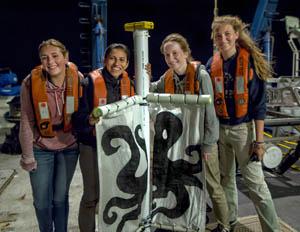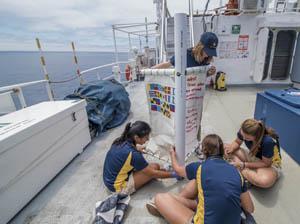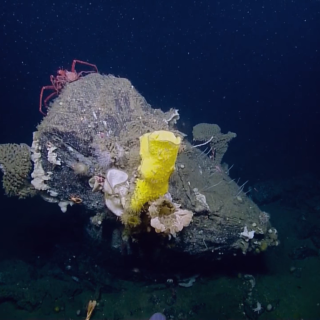Journey of a Lifetime: Rising High School Seniors Participate in Research with the Ocean Exploration Trust

By: Emily Vierling
As the last few days of the 2016 Honors Research Program (HRP) approach, it’s hard to believe that the amazing experience each of us have participated in for the past four weeks is coming to a close.
Every year, the Ocean Exploration Trust (OET) leads the Honors Research Program which offers eight rising high school seniors the opportunity to live and study at the University of Rhode Island’s Graduate School of Oceanography (GSO) for three weeks and to spend a week aboard the Exploration Vessel (E/V) Nautilus. The 2016 HRP students all brought our diverse backgrounds to the program including interests in robotics, biology, oceanography, and even extending into the realm of humanities and fine arts!
During our time at GSO, we worked alongside scientists, researchers, and engineers to learn about oceanography, marine biology, geology, ocean exploration, the application of technology in ocean exploration, presentation skills, and many more techniques that all of us will apply in our futures. On land we kept busy with two projects: ocean drifters and a public final presentation of our experience. We also worked on assembling an OpenROV as a side project. After our final presentation to the campus community, we were off to California for the “at-sea” component onboard the E/V Nautilus.
Designing and constructing a GPS-enabled surface ocean drifter was our capstone project while at GSO. The group was split into two teams, the girls and boys, as determined by sailing schedule. The girls' drifter team was comprised of four members: Myself (Emily), Leslie, Kendra, and Crista.
First, a little background. A surface drifter is a device that is built to float within one meter of the water’s surface. It spends multiple months at sea with the objective of recording surface current data in real time. The drifter has a GPS unit mounted to the top which can provide location data to computerized tracking programs. This allows our team, other students, educators or professional researchers to map its position over time. This year, HRP teamed up with Dr. Yi Chao, a researcher at Remote Sensing Solutions and the creator of CAROMS, a surface current prediction model. CAROMS has the ability to access and process past surface current data to predict a path an object would take after inputting a start location. The HRP team will provide the surface drifters’ data to Dr. Chao so he can use it to improve his model.
The GPS unit we used in our design has an average battery lifespan of about three to four months dependent on how often it sends out a ‘ping’ to the satellite. To conserve battery life, our GPS will send out a ‘ping’ every hour as opposed to a higher rate. The public will be able to track our drifter online as long as the battery holds out.
After conducting our research on the drifters and GPS systems, we were ready to begin our design. The first day was very productive. Within two hours we created an action plan, produced a solid design (see picture below, which was drawn by Crista) and a specific materials list.
Our team based the drifter design on the original Irina model (which uses an all aluminum frame), however, instead of using the more modern aluminum or bamboo frame, we reverted back to an older model by using PVC. We decided to use PVC because it was a familiar material and we knew how to control the ballast. Our design had a PVC pipe as the main mast and eight PVC spars extending outwards through a four-way PVC connector. The GPS was mounted in a watertight otterbox about two feet above the water level for its journey out at sea. For the sails we decided to use sail material because it was readily available to us from previous years and it was more durable in a marine environment compared to the commonly used canvas sails. We also decided to use plastic grommets instead of brass because of the risk of corrosion. This also served a more secure and less risky way to attach the sails to the PVC using plastic zip ties, inserted through the grommets, instead of glue because of the risk of glue erosion.
The main task was to make improvements to the Irina model. We made two major improvements: the type and location of the floatation. Our plan was to extend floatation along the entire length of the spars using pool noodles instead of having just four buoys tied to the end. The pool noodles would rest on four spars,allowing the buoyancy to be equally distributed. Another major change we made to the Irina design was to punch holes in the main mast. With the added weight of the water in the main mast combined with the lead weights and chain link in the bottom of the mast, these alterations would balance out the center of gravity with the added buoyancy on the spars.
The next few days we would continue to make final alterations and collect our supplies. At Home Depot we found most of the materials needed, including our PVC pipes, zip ties, rubber sealant, and caps. Any materials we didn’t purchase online or at Home Depot we repurposed from past years.
After we acquired our materials it was time to assemble and take our theoretical sketch and transform it into a reality! A shady spot on the GSO campus was used as we laid out our beloved Frozen blanket and got to work. Leslie and I cut the sails to the desired dimensions while Crista and Kendra tested the rubber sealant on the pool noodles. Because the pool noodles were porous and absorbed a lot of water, we decided to use a rubber sealant to extend their lifetime in a marine environment. The biggest challenge that we faced during our assemblement was drilling four extra holes in our PVC to fit the four-way spar connector. We went blind into the drilling of those holes, but in the end, the specifications were correct and we were able to successfully attach our spars to the main mast! The final hour of the day was spent making holes in the sails for the grommets and attaching the pool noodles to the spars with zip ties. The plastic grommets would arrive later and then were added to the sails. The final step was to box up our drifter and prepare it for the long journey to the west coast!

Twelve hours later, all of us sat in the hotel room staring at the ceiling. The next day, Sunday, we would board the E/V Nautilus. The ship, throughout the three weeks in Rhode Island, seemed like a distant reality - but here we were, only mere hours from embarking on our adventure at sea. On Sunday morning, the minutes seemed to go by slowly as we walked up the gangway onto the ship. Broad smiles and unhideable excitement in our eyes, we looked over ROVs Argus and Hercules and headed up to the social deck which was trimmed in beautifully hand crafted wood from Turkey.
And that brings us to this moment. For the past few days, Leslie, Crista, Kendra, and I have been acting as data loggers on E/V Nautilus. Between shifts we spend our time enjoying the ocean breeze, meeting the many members of the Corps of Exploration, eating, sleeping, and making finishing touches on the drifter before its launch. To make sure that our drifter was prepared for its journey, we added PVC cement solvent to the spars and its connectors to ensure that the spars would not come loose. To accommodate for the added layer of cement on the spars, we tried to expand the surface area. However, the spars did not hold and we had to drill through each spar and secure them to the main mast with zip ties. This is the moment we decided to name our beloved drifter “Zippy”.
Finally, the moment came to say goodbye. As we watched the hours of work, frustration, happiness, and success float away in the current I couldn’t help thinking what an amazing journey Zippy had taken us on. From that first day at GSO, all of us looking at the daunting task ahead of us with excitement, to this moment watching the yellow GPS bob up and down between the crests of waves. We are all grateful for what the HRP has taught us and this experience, I know, will hold a special place in our hearts forever.

Southern California Margin
In late summer, E/V Nautilus will be offshore Los Angeles to explore some of the most tectonically active (as well as densely populated) areas offshore California. The team will investigate the Southern California Margin, a broad area that fits entirely within the US Exclusive Economic Zone but that still remains largely unexplored.



